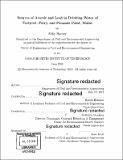Sources of arsenic and lead in drinking water of Eastport, Perry, and Pleasant Point, Maine
Author(s)
Harvey, Abby (Abigail P.)
DownloadFull printable version (10.70Mb)
Other Contributors
Massachusetts Institute of Technology. Department of Civil and Environmental Engineering.
Advisor
Harold Hemond and Kathleen Vandiver.
Terms of use
Metadata
Show full item recordAbstract
Lead and arsenic in drinking water are a health risk to communities throughout the world; lead can be a problem in houses with old piping systems with either lead piping or 50/50 lead solder, and groundwater in Maine contains high arsenic concentrations. This study sought to determine the prevalence and sources of arsenic and lead in the drinking water of Eastport, Perry, and Pleasant Point, Maine. Citizens of these towns submitted water samples from their homes, and arsenic and lead were measured in these samples. Each citizen submitted two samples: one where water stood in the pipes for a minimum of six hours, and another where the tap was flushed for 2+ minutes before sample collection. The primary water sources in the region were municipal water, from the Passamaquoddy Water District (PWD), and well water from private wells. Water samples were also collected from the source waters of the municipal water system, the Passamaquoddy Water District, and immediately following water treatment to determine sources of lead in the municipal system. Lead concentrations were found to be below the Environment Protection Agency (EPA) action level of 15ppb throughout the municipal system, and less than 1% of PWD samples exceeded the action level for lead in the standing samples. Overall, including houses with wells, 2% of houses exceeded the EPA action level in standing samples, and these houses are inferred to contain high lead levels in their piping. Arsenic levels in well water samples were found to exceed the EPA Guideline of 10[mu]g/L in 15% of samples, and did not depend on bedrock type, pH, or well depth, suggesting that bedrock heterogeneity and fracture geometry plays a large role in arsenic concentrations in this region.
Description
Thesis: M. Eng., Massachusetts Institute of Technology, Department of Civil and Environmental Engineering, 2018. Cataloged from PDF version of thesis. Includes bibliographical references (pages 58-61).
Date issued
2018Department
Massachusetts Institute of Technology. Department of Civil and Environmental EngineeringPublisher
Massachusetts Institute of Technology
Keywords
Civil and Environmental Engineering.